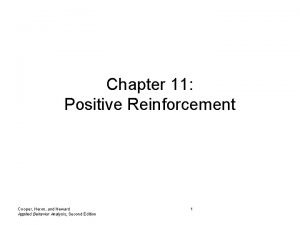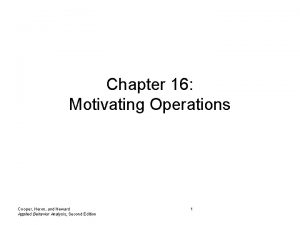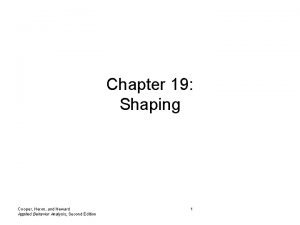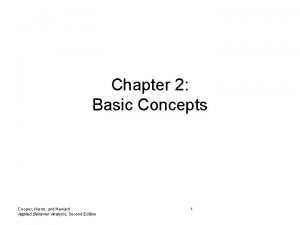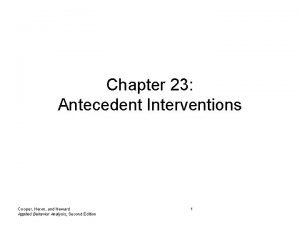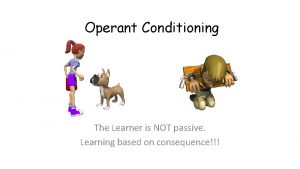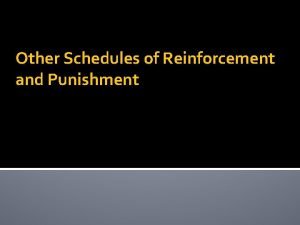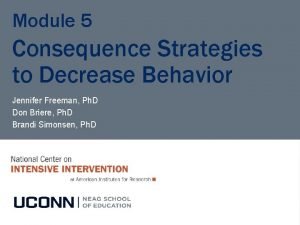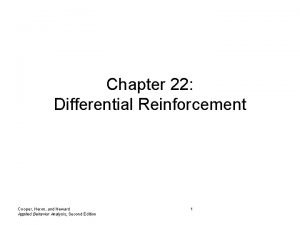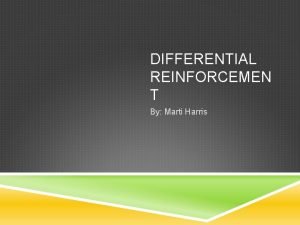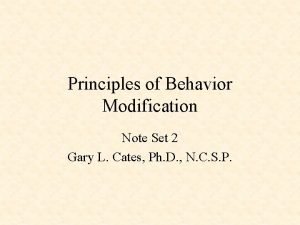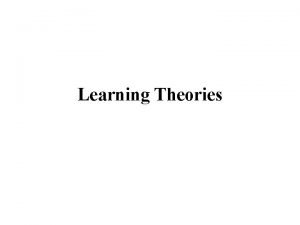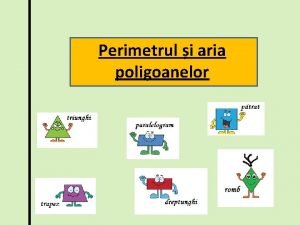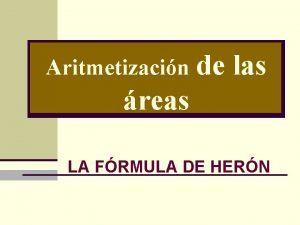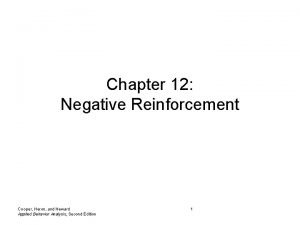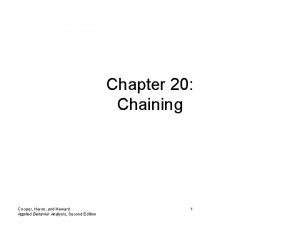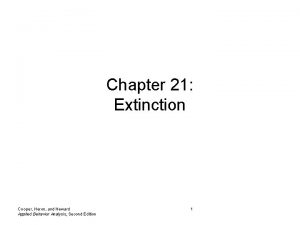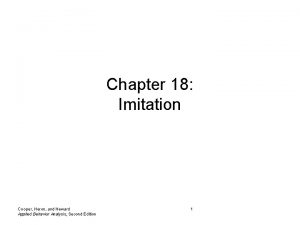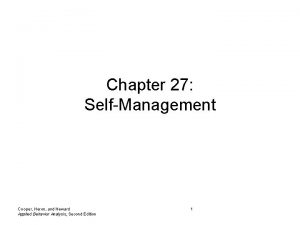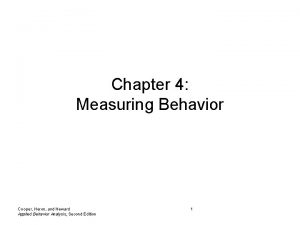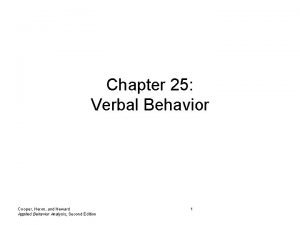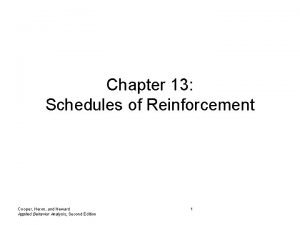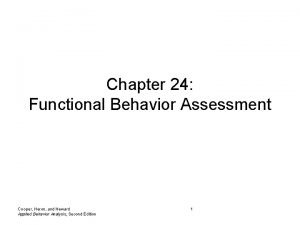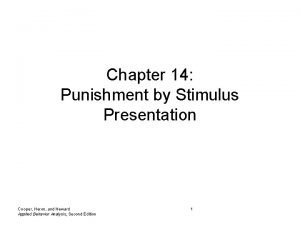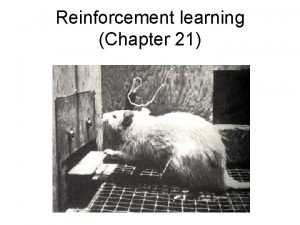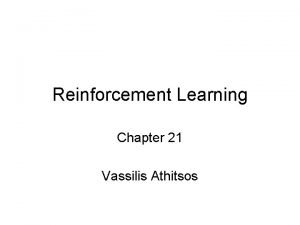Chapter 22 Differential Reinforcement Cooper Heron and Heward


























- Slides: 26

Chapter 22: Differential Reinforcement Cooper, Heron, and Heward Applied Behavior Analysis, Second Edition 1

Definition of Differential Reinforcement • Reinforcing one response class – When dealing with reducing problem behavior, this involves • Reinforcing a behavior other than problem behavior • Reinforcing a reduced rate of problem behavior • Withholding reinforcement for another Cooper, Heron, and Heward Applied Behavior Analysis, Second Edition 2

Diagram of Differential Reinforcement EO SD Response SR+ Deprived of one-on-one attention for a period of time “Play by your self while I wash the dishes” Child plays with toys Praise delivered Cooper, Heron, and Heward Applied Behavior Analysis, Second Edition Response SO Child tantrums Praise withheld 3 Playing with toys occurs more often in the future when the individual has been deprived of attention for periods of time Tantrums occur less often in the future when the individual has been deprived of attention for periods of time

DRI • DRI: Differential Reinforcement of Incompatible Behavior – Reinforce a behavior that cannot occur with problem behavior – Withhold reinforcement for instances of problem behavior Cooper, Heron, and Heward Applied Behavior Analysis, Second Edition 4

DRA • DRA: Differential Reinforcement of Alternative Behavior – Reinforce occurrences of desirable alternative to problem behavior but that is not necessarily incompatible – Reinforcement is withheld for problem behavior Cooper, Heron, and Heward Applied Behavior Analysis, Second Edition 5

A note on terminology… • Sometimes when reinforcer is a negative reinforcer: – DNRI • Differential negative reinforcement of incompatible behavior – DNRA • Differential negative reinforcement of alternative behavior Cooper, Heron, and Heward Applied Behavior Analysis, Second Edition 6

Guidelines for Implementing DRI/DRA • Select incompatible/alternative behavior – Already exists in repertoire – Requires equal or less effort than problem behavior – Emitted at a rate that provides sufficient opportunities for reinforcement – Likely to be reinforced in natural environment Cooper, Heron, and Heward Applied Behavior Analysis, Second Edition 7

Guidelines for Implementing DRI/DRA • Select potent reinforcers that can be controlled – Identify via stimulus preference assessment – Identify via functional behavior assessment • Use same consequence as is maintaining problem behavior for appropriate/incompatible behavior Cooper, Heron, and Heward Applied Behavior Analysis, Second Edition 8

Guidelines for Implementing DRI/DRA • Reinforce incompatible/alternative behavior immediately and consistently • Withhold reinforcement for problem behavior – Some “mistakes” may be tolerable • Combine with other procedures Cooper, Heron, and Heward Applied Behavior Analysis, Second Edition 9

DRO • Differential Reinforcement of Other Behavior – Deliver reinforcer whenever the problem behavior has not occurred for a specific time – “Reinforcement for not responding” Cooper, Heron, and Heward Applied Behavior Analysis, Second Edition 10

Forms of DRO • Fixed-interval DRO (FI-DRO) – Omission requirement is applied at the end of successive time intervals of equal duration • To apply: – Establish interval – Deliver reinforcement at end of interval if problem behavior didn’t occur during the interval – If problem behavior occurs, reset interval Cooper, Heron, and Heward Applied Behavior Analysis, Second Edition 11

Forms of DRO • Variable-interval DRO (VI-DRO) – Omission requirement is applied at the end of successive time intervals of variable and unpredictable durations • To apply: – Establish variable interval schedule – Deliver reinforcement at end of interval if problem behavior didn’t occur during the interval – If problem behavior occurs, reset interval Cooper, Heron, and Heward Applied Behavior Analysis, Second Edition 12

Forms of DRO • Fixed-momentary DRO (FM-DRO) and Variable-momentary DRO (VM-DRO) – Omission requirement is applied only at the end of successive time intervals of fixed or variable durations (contingency not in place during interval) • To apply: – Establish interval – Deliver reinforcement at end of interval if problem behavior didn’t occur at the end of the interval Cooper, Heron, and Heward Applied Behavior Analysis, Second Edition 13

What type of DRO to use? • Interval more widely used than momentary • Interval more effective for more suppressing problem behavior • Momentary may be most useful for maintaining reduced levels of problem behavior Cooper, Heron, and Heward Applied Behavior Analysis, Second Edition 14

Guidelines for Using DRO • Recognize limitations – Reinforcement provided if absence of target problem behavior. • If another, nontargeted problem behavior occurs, it is reinforced. – May need to shorten interval – May need to include other problem behaviors in definition Cooper, Heron, and Heward Applied Behavior Analysis, Second Edition 15

Guidelines for Using DRO • Recognize limitations – With Momentary DROs, reinforcement is delivered if problem behavior is not occurring at end of interval, even if it occurred throughout the majority of the interval • Change to interval DRO • Shorten interval Cooper, Heron, and Heward Applied Behavior Analysis, Second Edition 16

Guidelines for Using DRO • Set initial DRO intervals that assure frequent reinforcement – Calculate mean baseline interresponse time (IRT) – Set interval that is equal to or slightly less than mean IRT • Do not inadvertently reinforce other undesirable behaviors – Make rule: must have absence of target problem behavior and other inappropriate behaviors Cooper, Heron, and Heward Applied Behavior Analysis, Second Edition 17

Guidelines for Using DRO • Gradually increase the DRO interval – Three options: • Increase by constant duration of time • Increase intervals proportionately • Increase based on learner’s performance • Extend to other settings and times of day • Combine with other procedures Cooper, Heron, and Heward Applied Behavior Analysis, Second Edition 18

DRL • Differential Reinforcement of Low Rates of Responding – Use to decrease the frequency of the occurrence of a behavior, but not eliminate it all together Cooper, Heron, and Heward Applied Behavior Analysis, Second Edition 19

DRL • Full-session DRL – Reinforcement is delivered at the end of a session if during the entire session, the target behavior occurred equal to or fewer times than a predetermined criterion Cooper, Heron, and Heward Applied Behavior Analysis, Second Edition 20

DRL • Interval DRL – Divide the total session into a series of equal intervals of time – Provide reinforcement at the end of each interval in which the number of occurrences of target behavior is equal to or below predetermined criterion Cooper, Heron, and Heward Applied Behavior Analysis, Second Edition 21

DRL • Spaced-responding DRL – Deliver reinforcer following an occurrence of a behavior that is separated by at least a minimum amount of time from a previous behavior – In other words, reinforcement is contingent on increasingly longer IRTs Cooper, Heron, and Heward Applied Behavior Analysis, Second Edition 22

Guidelines for Using DRL • Recognize limitations – DRL is slow and does not reduce a behavior quickly Cooper, Heron, and Heward Applied Behavior Analysis, Second Edition 23

Guidelines for Using DRL • Choose most appropriate DRL procedure – Spaced responding is the only DRL procedure that delivers reinforcement immediately following response and maintains lower rates – Use full-session and interval DRO when it is okay to have either no or low rates of target behavior – Spaced responding provides higher rates of reinforcement Cooper, Heron, and Heward Applied Behavior Analysis, Second Edition 24

Guidelines for Using DRL • Use baseline data to guide selection of initial response or IRT limits – Set at mean baseline or slightly lower • Gradually thin the DRL schedule – Full-session DRL: set new criterion based on learner’s current performance – Interval DRL: gradually decrease number of responses per interval – Spaced-responding: adjust IRT criterion based on performance Cooper, Heron, and Heward Applied Behavior Analysis, Second Edition 25

Guidelines for Using DRL • Provide informational feedback to the learner – Enhance effectiveness by helping learner monitor performance Cooper, Heron, and Heward Applied Behavior Analysis, Second Edition 26
 Pre task choice aba
Pre task choice aba Conditioned motivating operations examples
Conditioned motivating operations examples An example of shaping within a response topography is:
An example of shaping within a response topography is: Cooper heron heward
Cooper heron heward Noncontingent reinforcement cooper
Noncontingent reinforcement cooper Secondary reinforcement psychology definition
Secondary reinforcement psychology definition Differential reinforcement of diminishing rates example
Differential reinforcement of diminishing rates example Consequence strategy examples
Consequence strategy examples Differential behavior definition
Differential behavior definition Differential reinforcement theory
Differential reinforcement theory Differential reinforcement
Differential reinforcement Differential reinforcement
Differential reinforcement Differential reinforcement theory
Differential reinforcement theory Formula ariei triunghiului
Formula ariei triunghiului Christiaan huygens teoria ondulatoria de luz
Christiaan huygens teoria ondulatoria de luz Katherine mansfield leslie heron beauchamp
Katherine mansfield leslie heron beauchamp Heron method
Heron method Heron's formula introduction
Heron's formula introduction Heron alexandrijský
Heron alexandrijský Como hacer una fuente de heron
Como hacer una fuente de heron Diamond css
Diamond css Area formula de heron
Area formula de heron Heron glen tee times
Heron glen tee times Heron lakes golf course houston
Heron lakes golf course houston Heron von alexandria geboren
Heron von alexandria geboren Heron bird
Heron bird Dwight heron
Dwight heron
